DLEON INC PART Statements and Taxes Donna Jamison a 2009 gra
Solution
MINI CASE
Donna Jamison, a recent graduate of the University of Tennessee with four years of banking experience, was recently brought in as assistant to the chairman of the board of Computron Industries, a manufacturer of electronic calculators.
The company doubled its plant capacity, opened new sales offices outside its home territory, and launched an expensive advertising campaign. Computron’s results were not satisfactory, to put it mildly. Its board of directors, which consisted of its president and vice-president plus its major stockholders (who were all local business people), was most upset when directors learned how the expansion was going. Suppliers were being paid late and were unhappy, and the bank was complaining about the deteriorating situation and threatening to cut off credit. As a result, Al Watkins, Computron’s president, was informed that changes would have to be made, and quickly, or he would be fired. Also, at the board’s insistence Donna Jamison was brought in and given the job of assistant to Fred Campo, a retired banker who was Computron’s chairman and largest stockholder. Campo agreed to give up a few of his golfing days and to help nurse the company back to health, with Jamison’s help.
Jamison began by gathering financial statements and other data. Assume that you are Jamison’s assistant, and you must help her answer the following questions for Campo.
Balance Sheets
Assets
2003
2004
Cash
$ 9,000
$ 7,282
Short-term investments.
48,600
20,000
Accounts receivable
351,200
632,160
Inventories
715,200
1,287,360
total current assets
$ 1,124,000
$ 1,946,802
Gross fixed assets
491,000
1,202,950
Less: accumulated depreciation
146,200
263,160
net fixed assets
$ 344,800
$ 939,790
Total assets
$ 1,468,800
$ 2,886,592
Liabilities and equity
2003
2004
Accounts payable
$ 145,600
$ 324,000
Notes payable
200,000
720,000
Accruals
136,000
284,960
total current liabilities
$ 481,600
$ 1,328,960
Long-term debt
323,432
1,000,000
Common stock (100,000 shares)
460,000
460,000
Retained earnings
203,768
97,632
total equity
$ 663,768
$ 557,632
Total liabilities and equity
$ 1,468,800
$ 2,886,592
Income Statements
2003
2004
Sales
$ 3,432,000
$ 5,834,400
Cost of goods sold
2,864,000
4,980,000
Other expenses
340,000
720,000
Depreciation
18,900
116,960
total operating costs
$ 3,222,900
$ 5,816,960
EBIT
$ 209,100
$ 17,440
Interest expense
62,500
176,000
EBT
$ 146,600
$ (158,560)
Taxes (40%)
58,640
(63,424)
Net income
$ 87,960
$ (95,136)
Other data
2002
2003
Stock price
$ 8.50
$ 6.00
Shares outstanding
100,000
100,000
EPS
$ 0.880
$ (0.951)
DPS
$ 0.220
$ 0.110
Statement of retained earnings, 2004
Balance of retained earnings, 12/31/2003
$ 203,768
add: net income, 2004
$ (95,136)
less: dividend paid, 2004
$ (11,000)
Balance of retained earnings, 12/31/2004
$ 97,632
Statement of Cash Flows
Operating activities
Net income
$ (95,136)
Adjustments:
noncash adjustments:
depreciation
116,960
changes in working capital:
change in accounts receivable
(280,960)
change in inventories
(572,160)
change in accounts payable
178,400
change in accruals
148,960
Net cash provided by operating activities
$ (503,936)
Long-term investing activities
Cash used to acquire fixed assets
$ (711,950)
Financing activities
change in short term investments
$ 28,600
change in notes payable
$ 520,000
change in long-term debt
$ 676,568
change in common stock
$ -
payment of cash dividends
$ (11,000)
Net cash provided by financing activities
$ 1,214,168
Summary
Net change in cash
$ (1,718)
Cash at beginning of year
9,000
Cash at end of year
$ 7,282
a. What effect did the expansion have on sales and net income? What effect did the expansion have on the asset side of the balance sheet? What effect did it have on liabilities and equity?
Answer: Sales increased by over by over $2.4 million, but net income fell by over $190,000. Assets almost doubled. Debt and funds provided by suppliers increased, but retained earnings fell due to the year’s loss.
b. What do you conclude from the statement of cash flows?
Answer: Net CF from operations = -$503,936, because of negative net income and increases in working capital. The firm spent $711,950 on FA. The firm borrowed heavily and sold some short-term investments to meet its cash requirements. Even after borrowing, the cash account fell by $1,718.
c. What is free cash flow? Why is it important? What are the five uses of FCF?
Answer: FCF is the amount of cash available from operations for distribution to all investors (including stockholders and debtholders) after making the necessary investments to support operations. A company’s value depends upon the amount of FCF it can generate.
1. Pay interest on debt.
2. Pay back principal on debt.
3. Pay dividends.
4. Buy back stock.
5. Buy nonoperating assets (e.g., marketable securities, investments in other companies, etc.)
d. What are operating current assets? What are operating current liabilities? How much net operating working capital and total net operating capital does Computron have?
Answer: Operating current assets are the CA needed to support operations. OP CA include: cash, inventory, receivables. OP CA exclude: short-term investments, because these are not a part of operations. Operating current liabilities are the CL resulting as a normal part of operations. OP CL include: accounts payable and accruals. OP CA exclude: notes payable, because this is a source of financing, not a part of operations.
NOWC = operating CA – operating CL
NOWC04 = ($7,282 + $632,160 + $1,287,360) - ($324,000 + $284,960)
= $1,317,842.
NOWC03 = $793,800.
Total operating working capital = NOWC + net fixed assets.
Operating capital in 2004 = $1,317,842 + $939,790
= $2,257,632.
Operating capital in 2003 = $1,138,600.
e. What are Computron’s net operating profit after taxes (NOPAT) and free cash flow (FCF)?
ANSWER: NOPAT = EBIT(1 - Tax rate)
NOPAT04 = $17,440(1 - 0.4)
= $10,464.
NOPAT03 = $125,460.
FCF = NOPAT - Net investment in capital
= $10,464 - ($2,257,632 - $1,138,600)
= $10,464 - $1,119,032
= -$1,108,568.
f. Calculate Computron’s return on invested capital. Computron has a 10% cost of capital (WACC). Do you think Computron’s growth added value?
ANSWER: ROIC = NOPAT / Total NET operating capital.
ROIC04 = $10,464 / $2,257,632
= 0.5%.
ROIC03 = 11.0%.
The ROIC of 0.5% is less than the WACC of 10%. Investors did not get the return they require. Note: high growth usually causes negative FCF (due to investment in capital), but that’s ok if ROIC > WACC. For example, home depot has high growth, negative FCF, but a high ROIC.
g. Jamison also has asked you to estimate Computron\'s EVA. She estimates that the after-tax cost of capital was 10 percent in both years.
ANSWER: EVA = NOPAT- (WACC)(Capital).
EVA04 = $10,464 - (0.1)($2,257,632)
= $10,464 - $225,763
= -$215,299.
EVA03 = $125,460 - (0.10)($1,138,600)
= $125,460 - $113,860
= $11,600.
h. What happened to Computron\'s market value added (MVA)?
Answer: MVA = market value of the firm - book value of the firm.
Market value = (# shares of stock)(price per share) + value of debt.
Book value = total common equity + value of debt.
If the market value of debt is close to the book value of debt, then MVA is market value of equity minus book value of equity. Assume market value of debt equals book value of debt.
Market value of equity 2003 = (100,000)($6.00) = $600,000.
Book value of equity 2003 = $557,632.
MVA03 = $600,000 - $557,632 = $42,368.
MVA02 = $850,000 - $663,768 = $186,232.
i. Assume that a corporation has $100,000 of taxable income from operations plus $5,000 of interest income and $10,000 of dividend income. What is the company’s tax liability?
Answer: Calculation of the company’s tax liability:
Taxable operating income $100,000
Taxable interest income 5,000
Taxable dividend income (0.3 ´ $10,000) 3,000
Total taxable income $108,000
Tax = $22,250 + ($108,000 - $100,000)0.39 = $25,370.
taxable dividend income = dividends - exclusion
= $10,000 - 0.7($10,000)
= $3,000.
j. Assume that you are in the 27 percent marginal tax bracket and that you have $5,000 to invest. You have narrowed your investment choices down to California bonds with a yield of 7 percent or equally risky Exxon bonds with a yield of 10 percent. Which one should you choose and why? At what marginal tax rate would you be indifferent to the choice between California and Exxon bonds?
Answer: After-tax return income at t = 27%:
Exxon = 0.10($5,000) - (0.10)($5,000)(0.27) = $365.
California = 0.07($5,000) - $0 = $350.
Alternatively, calculate after-tax yields:
A-T yieldExxon = 10.0%(1 - t) = 10%(1 - 0.27) = 7.3%.
A-T yieldCalif. = 7.0%.
At what marginal tax rate would you be indifferent?
7.0% = 10.0%(1 - t). Solve for t.
7.0% = 10.0% - 10.0%(t)
10.0%(t) = 3%
t = 30%.
| Assets | 2003 | 2004 | |
| Cash | $ 9,000 | $ 7,282 | |
| Short-term investments. | 48,600 | 20,000 | |
| Accounts receivable | 351,200 | 632,160 | |
| Inventories | 715,200 | 1,287,360 | |
| total current assets | $ 1,124,000 | $ 1,946,802 | |
| Gross fixed assets | 491,000 | 1,202,950 | |
| Less: accumulated depreciation | 146,200 | 263,160 | |
| net fixed assets | $ 344,800 | $ 939,790 | |
| Total assets | $ 1,468,800 | $ 2,886,592 | |
| Liabilities and equity | 2003 | 2004 | |
| Accounts payable | $ 145,600 | $ 324,000 | |
| Notes payable | 200,000 | 720,000 | |
| Accruals | 136,000 | 284,960 | |
| total current liabilities | $ 481,600 | $ 1,328,960 | |
| Long-term debt | 323,432 | 1,000,000 | |
| Common stock (100,000 shares) | 460,000 | 460,000 | |
| Retained earnings | 203,768 | 97,632 | |
| total equity | $ 663,768 | $ 557,632 | |
| Total liabilities and equity | $ 1,468,800 | $ 2,886,592 |
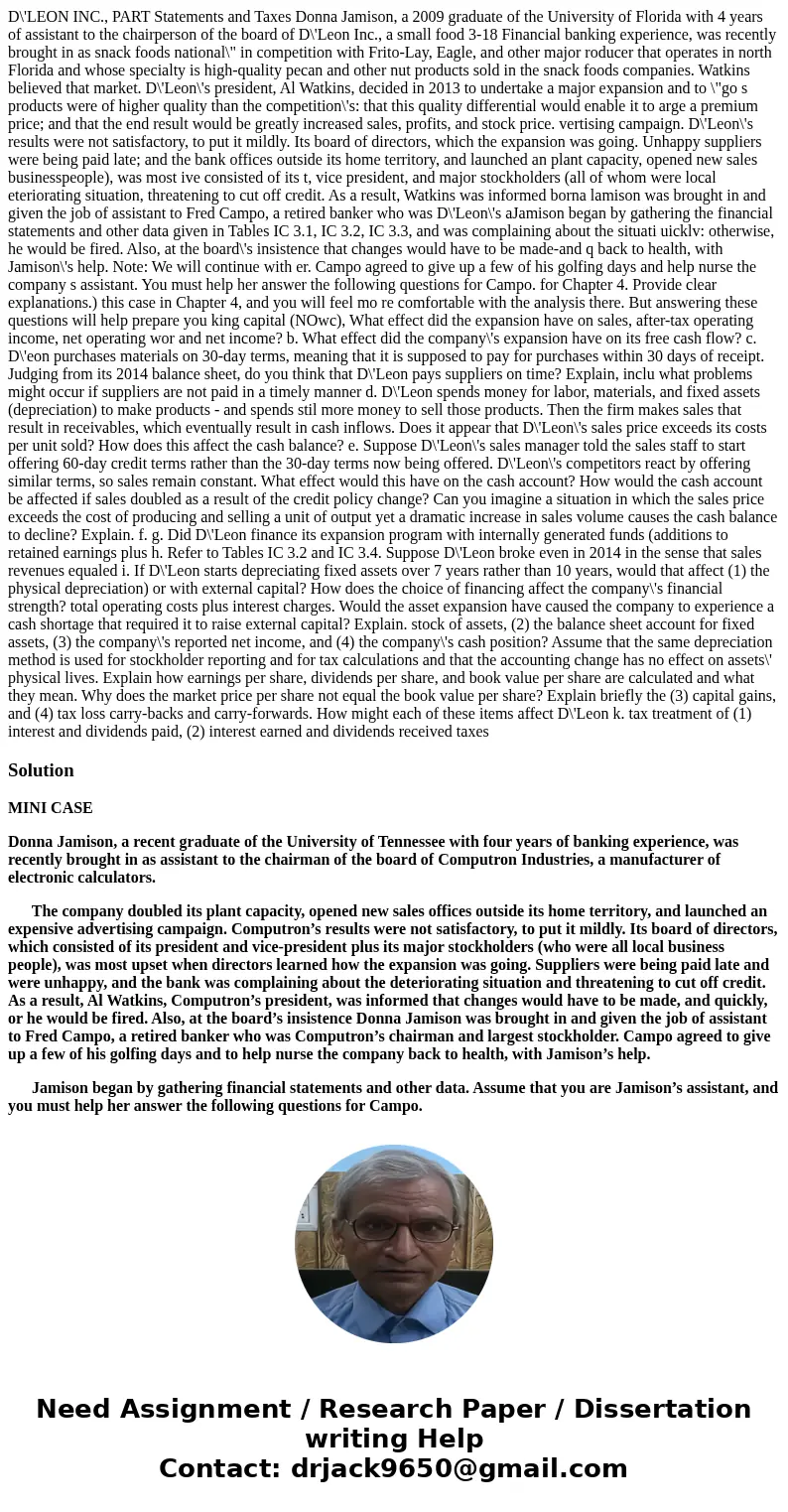
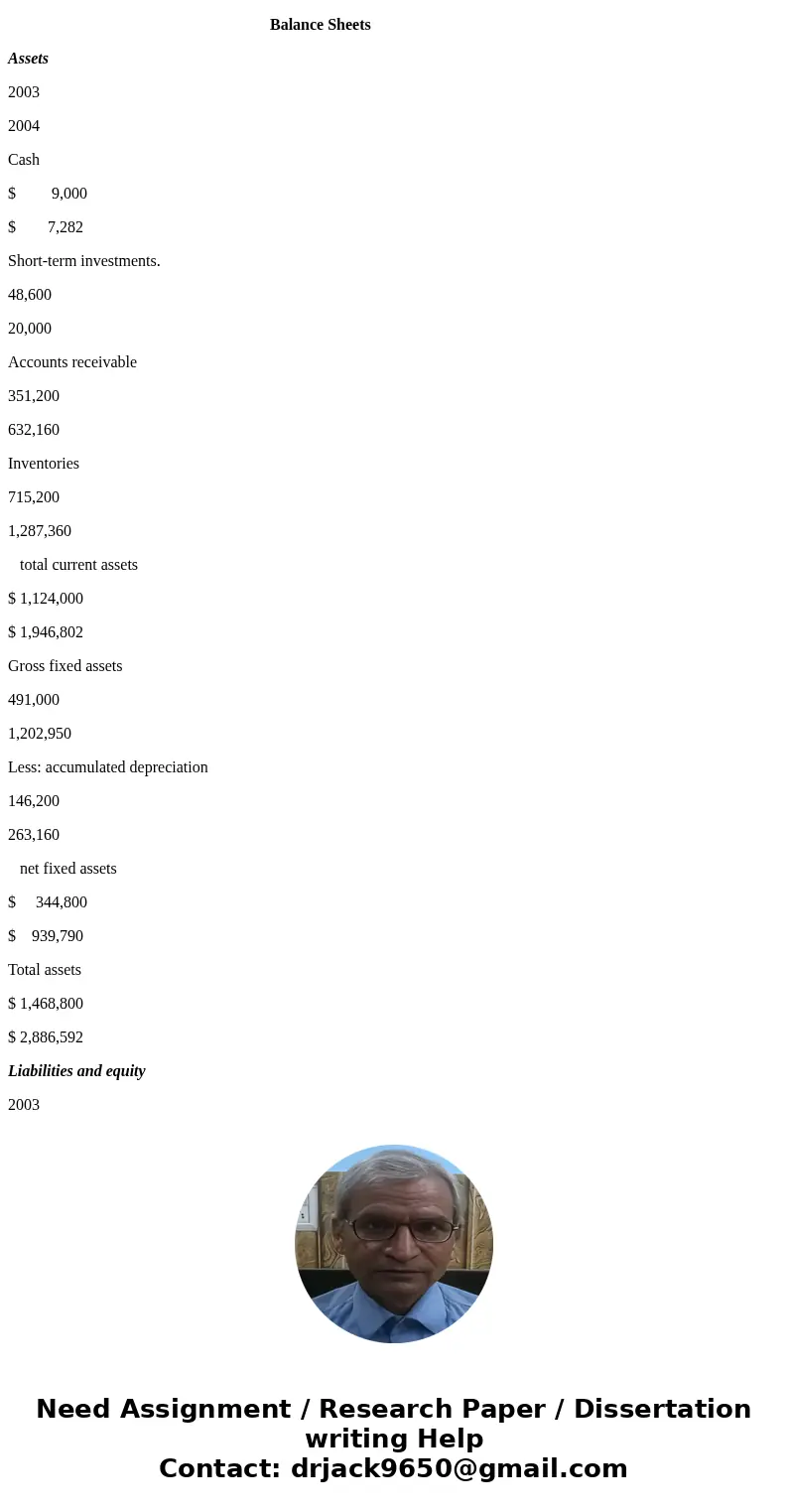
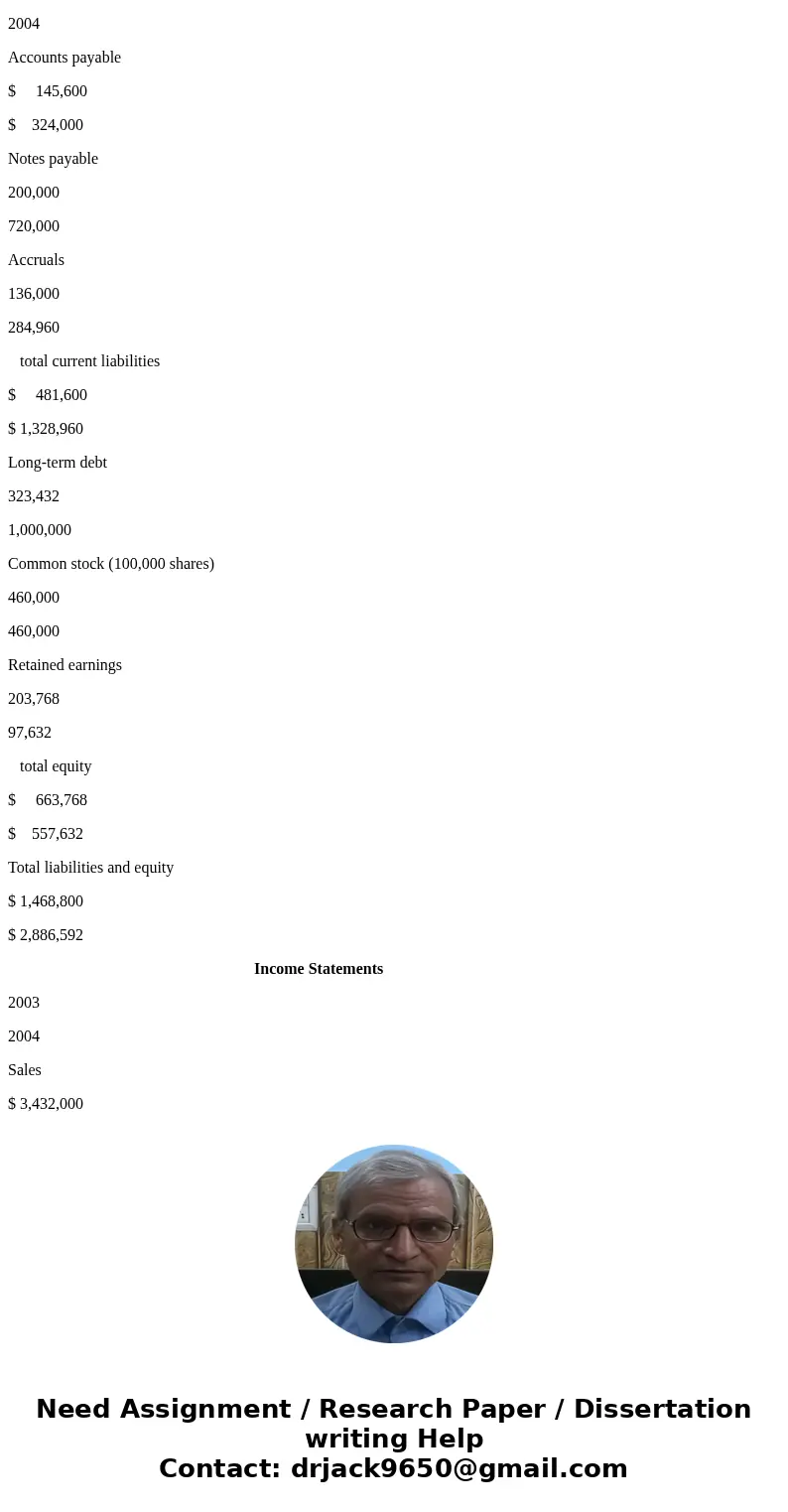
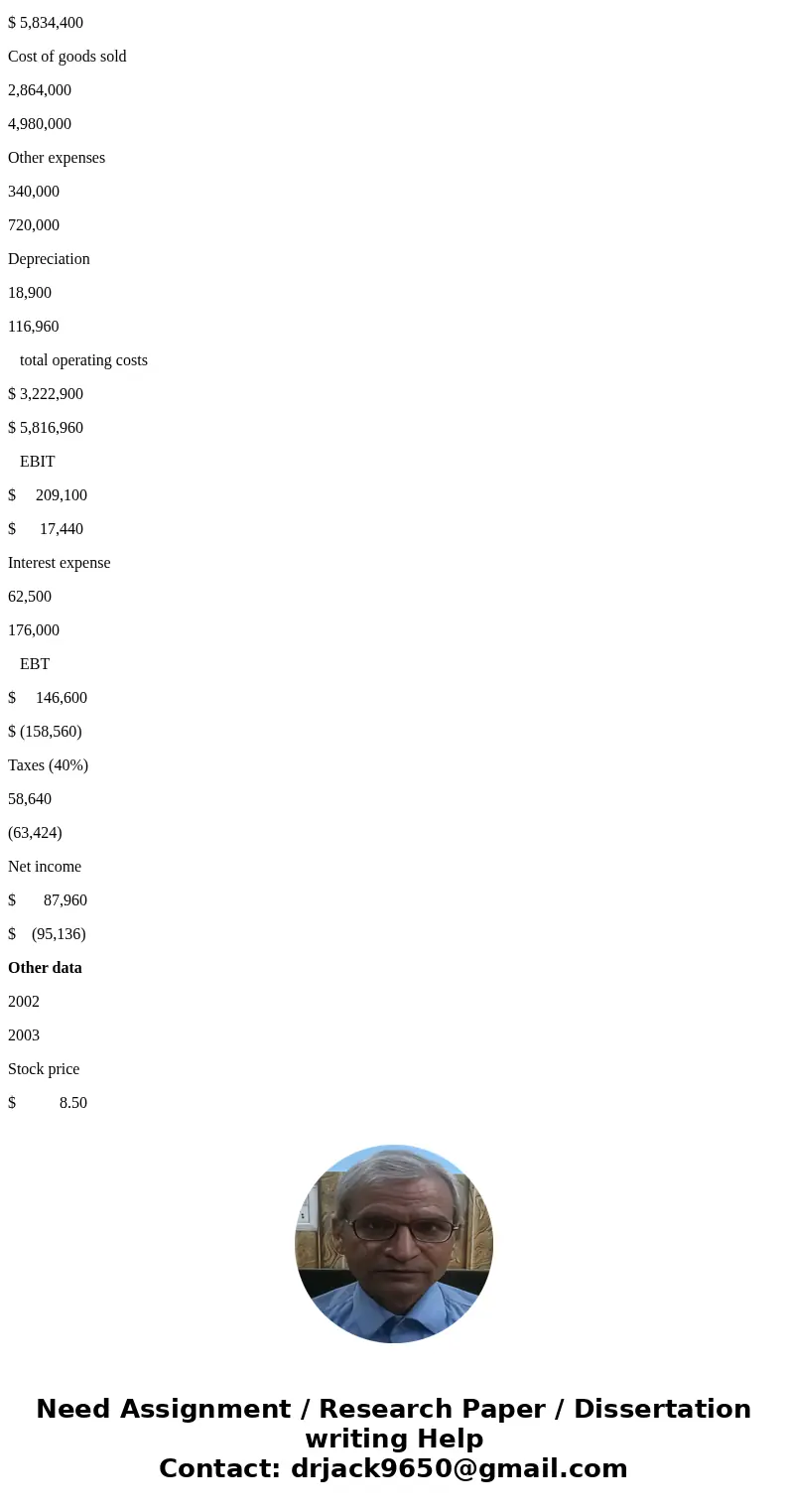
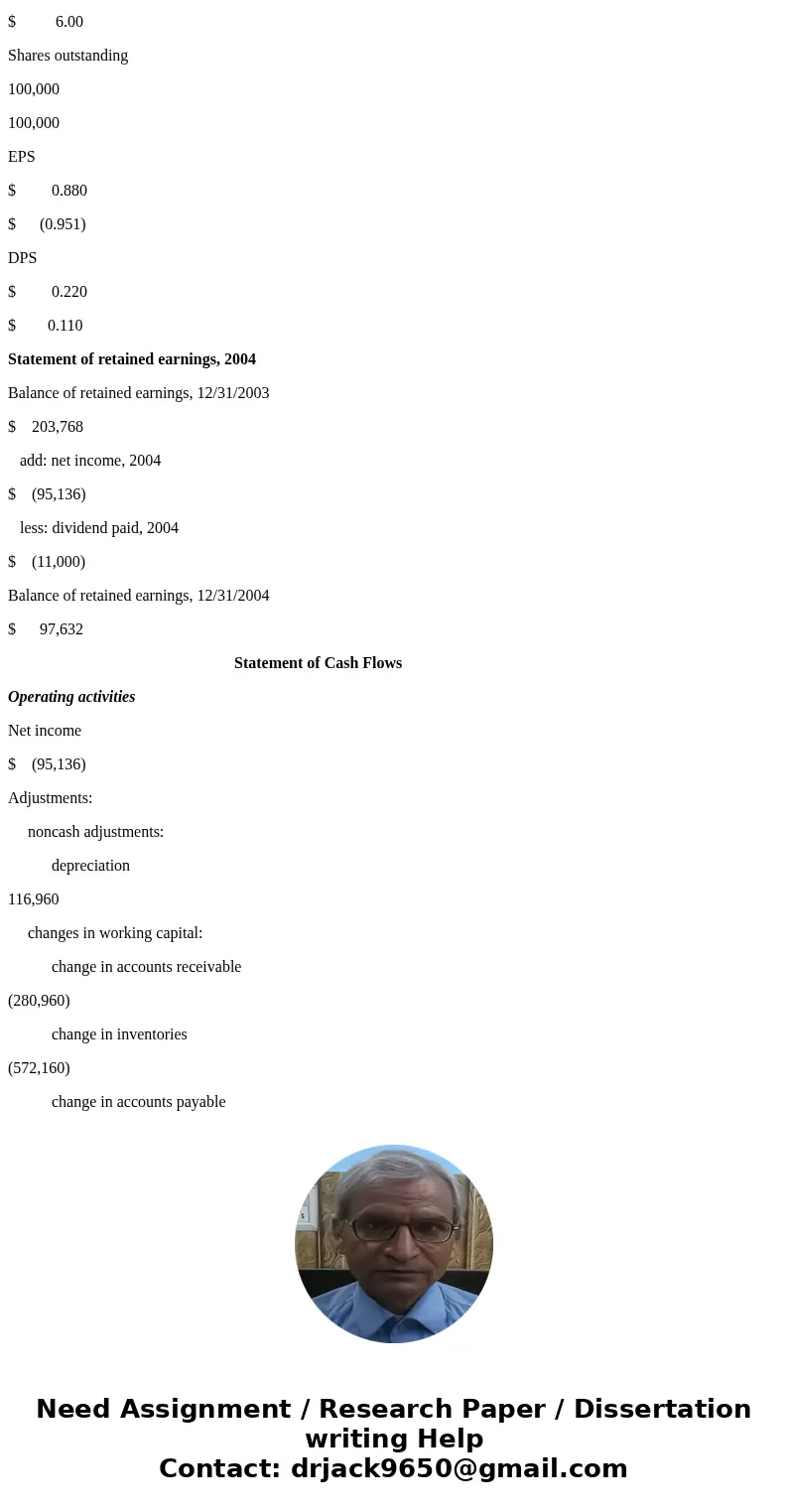
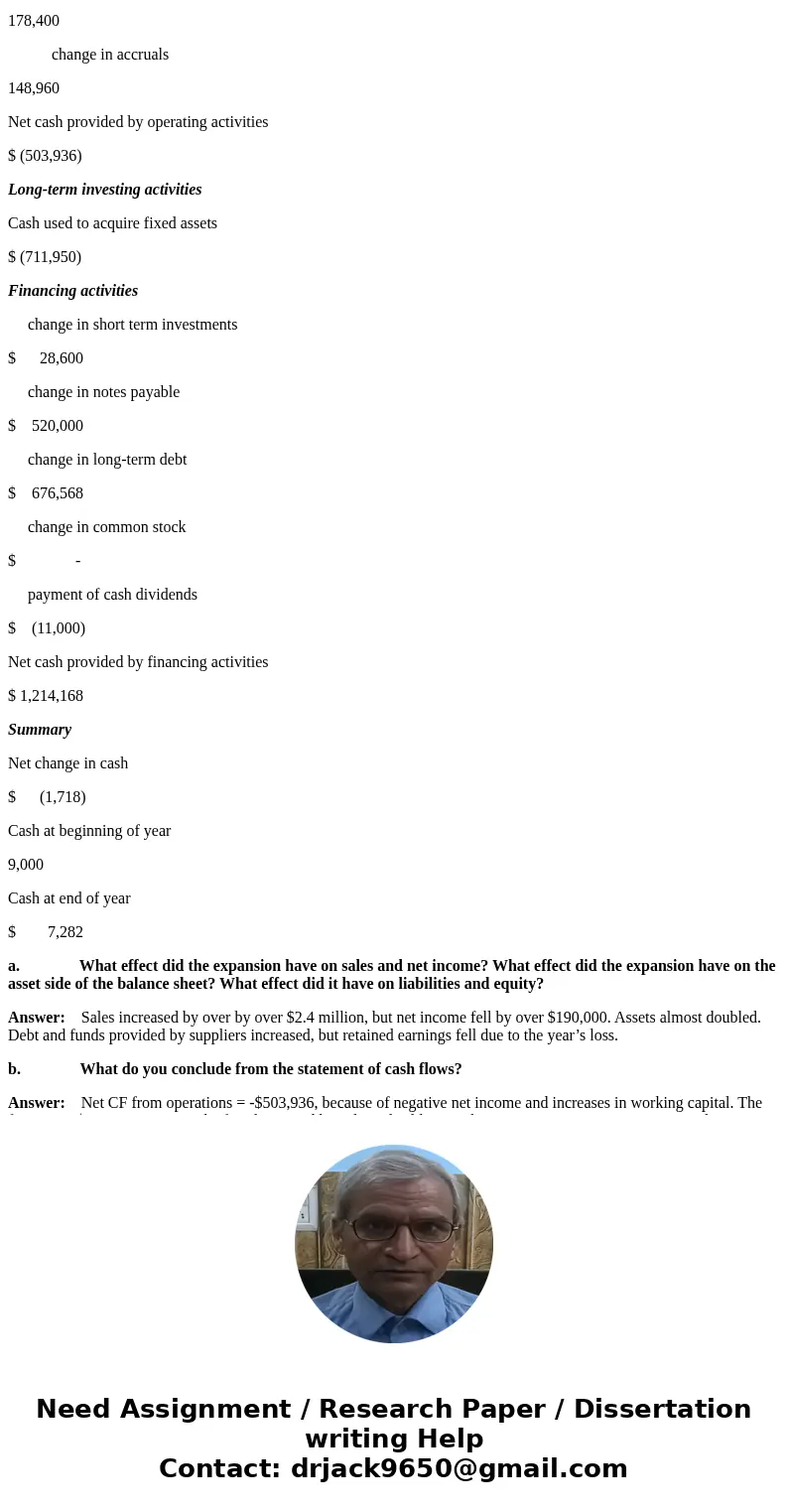
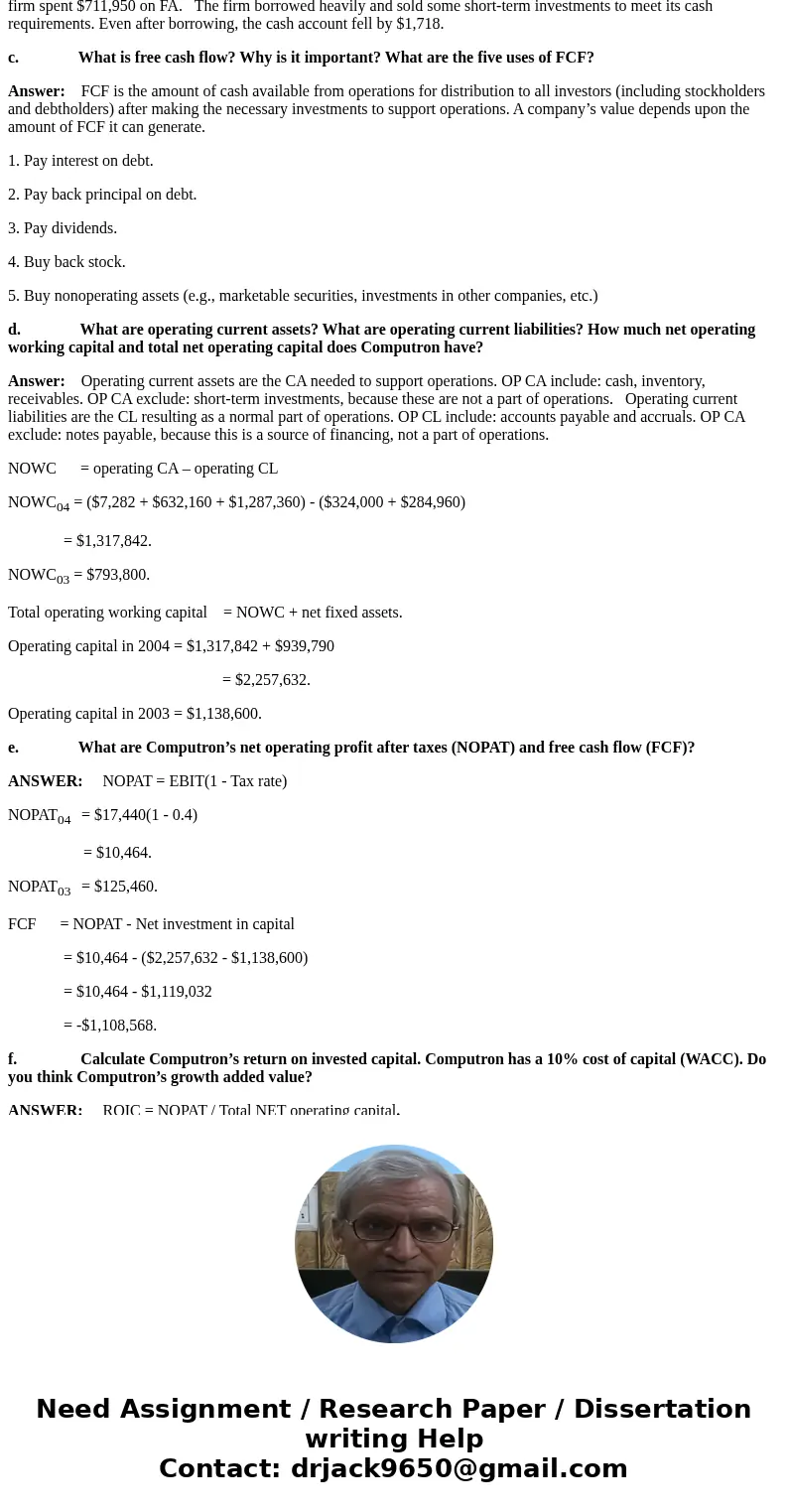
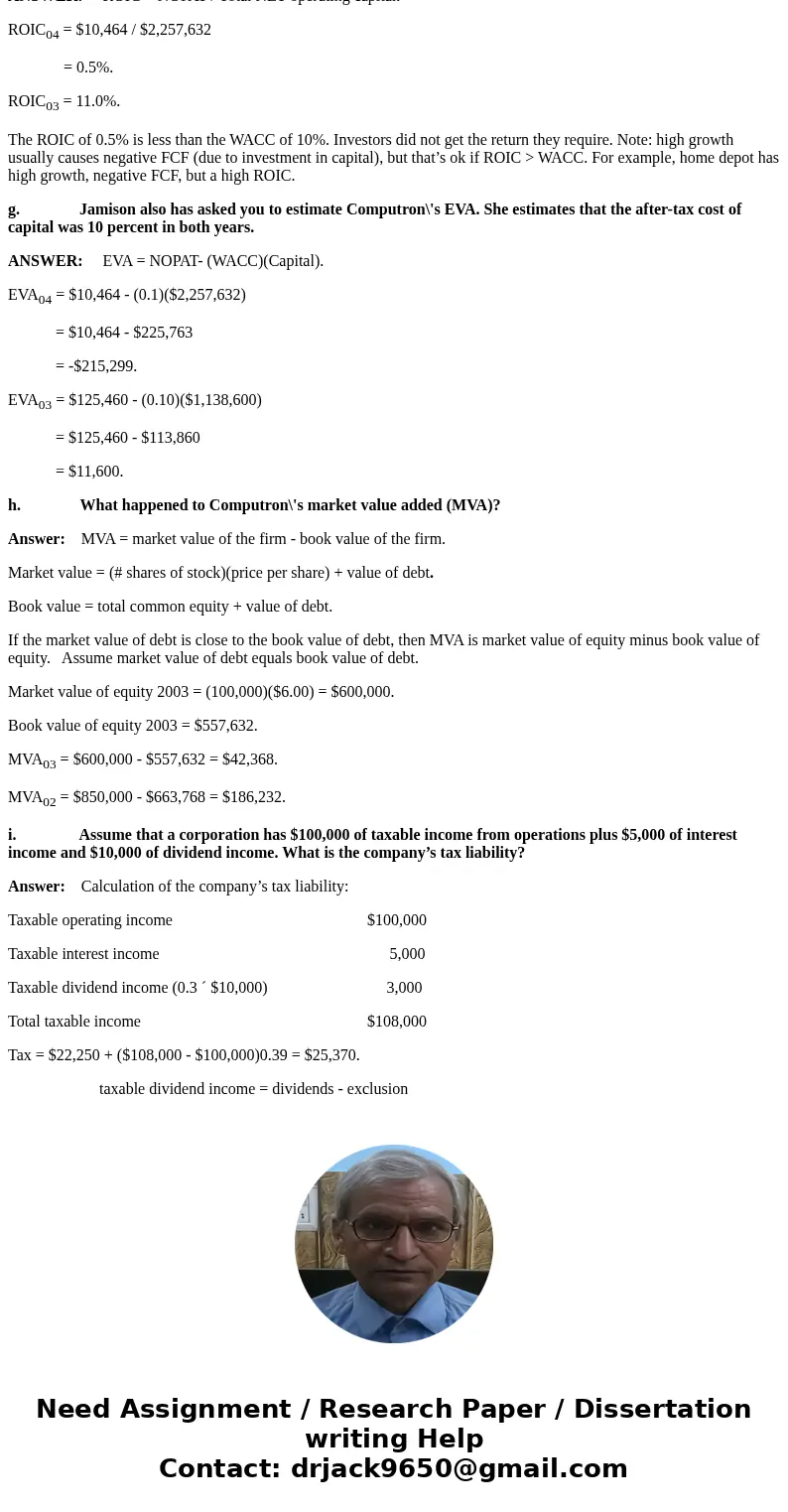
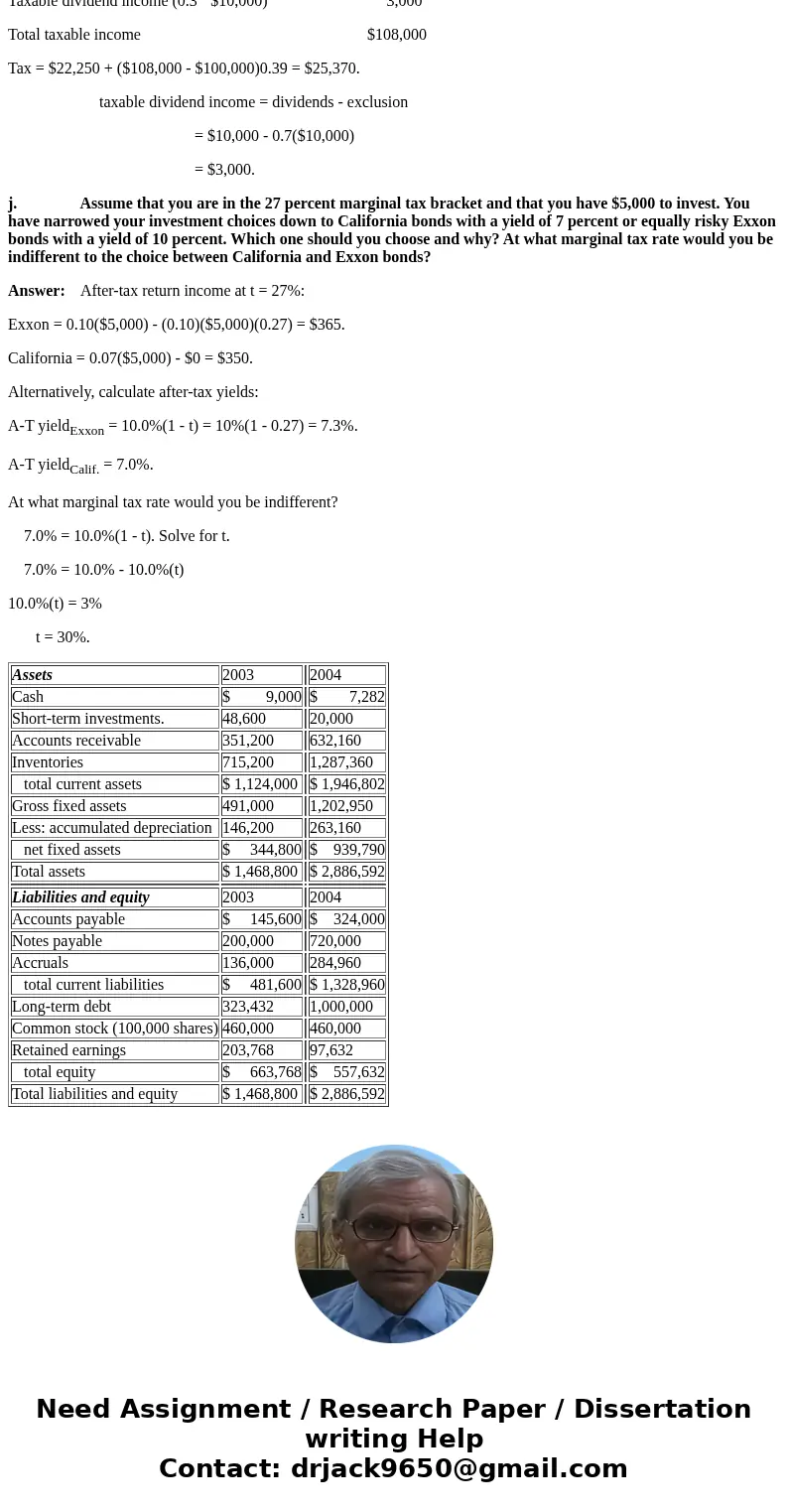
 Homework Sourse
Homework Sourse